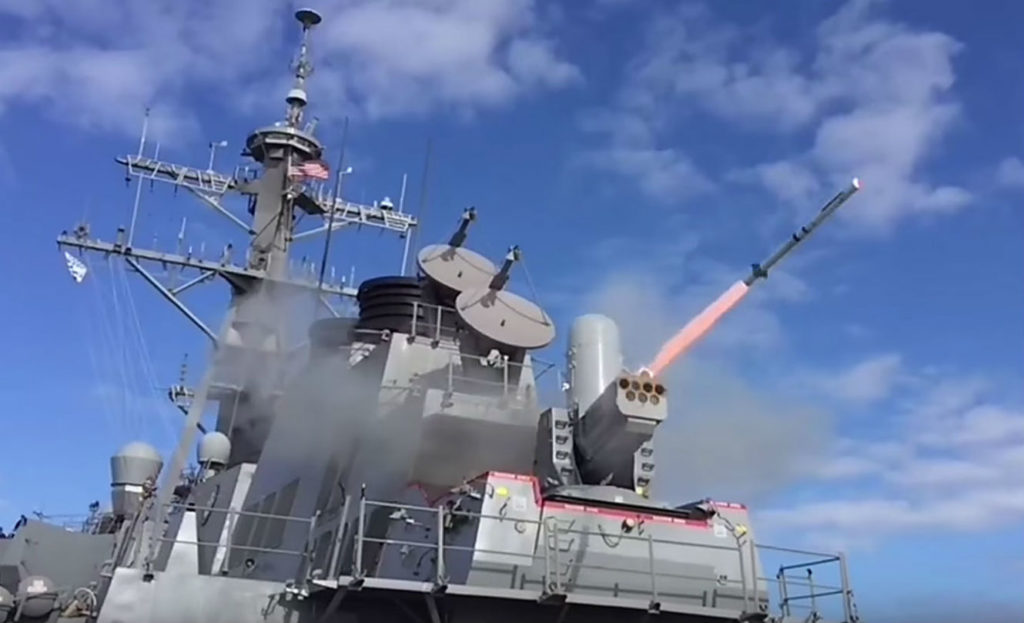The Navy Littorally Has a Drone Problem

The idea of non-state actors attacking from the sea is not new. We merely have to look at attacks by Somali pirates or Al Qaeda’s attack on USS Cole for historical precedent. Similarly, there are centuries of precedent for land-based attacks on ships. But, drone technological advances that are already on the horizon change the situation by diversifying both the types of threats and weaponry and also places them in the hands of non-state actors.
Defending ships worth hundreds of millions of dollars against thousand dollar drones creates a perilous economic game and changes the risk calculus of the Navy’s presence mission. We were recently given an early indication of how this might happen. Houthi rebels in Yemen reportedly fired missiles at the USS Mason multiple times in recent weeks. These conventional attacks by an unconventional force did not successfully hit their target but merit our attention as this scenario may repeat itself in the not-too distant future with unmanned aerial vehicles mounted with explosives.
As discussed by Ulrike Franke, the booby-trapped IED that recently wounded French special operators in Syria showed that low-cost, commercially available, payload-carrying drones are now being weaponized. T.X. Hammes gave a bracing assessment on the “democratization of airpower,” discussing how technologies available to non-state groups could change the character of warfare. Mark Jacobsen argued that the most dangerous insurgent operated drones will be custom-built rather than purchased “off of the shelf” and adapted from there. As 3D printing technologies advance and become more affordable, they explain, non-state actors will be capable of producing their own deadly drones. However, Hammes and Jacobson attacked the problem largely from the perspective of operations on or over land. The U.S. Navy must also face this challenge.
How might this threat to our maritime assets manifest itself? The littorals will become evermore dangerous.
Looking further into the future, machine learning could allow these drones to identify and select specific targets with little human involvement, which would be critical on long distance raids over the horizon. Jacobsen explained how his team created drones capable of flying up to 80 miles with a two-pound payload or 40 miles with a four-pound payload. This sort of technology would make land-based attacks on naval ships near the coastline possible.
If non-flagged, or deceptively flagged, seemingly benign vessels sail into territorial waters, they can narrow the gap between the drone launch point and their final target. One can imagine a scenario where multiple non-state ships, similar to the “little blue men” of the Chinese Maritime Militia, close with U.S. warships under the protected veil of a civilian craft before launching waves of drones.
If these launching platforms can get close enough to get their drones within range of U.S. forces, their flying IEDs used en masse would present a serious problem for U.S. vessels. U.S. Navy ships are equipped with either the Ship Self-Defense System (SSDS) or Aegis Combat System to defend against airborne missile attacks. Neither system is designed to defeat small, maneuverable drones. That leaves the close-in weapon system (CIWS) as the lone defender of the ship. CIWS identifies, tracks, and neutralizes close airborne contacts that have penetrated the ship’s long-range defenses. If the swarm of attacking drones were numerous enough, it is likely that a few could slip past the CIWS defense bubble. And a few is all it would take to disable a ship or seriously interrupt operations. For instance, drones could be “trained” to hunt and kill — with shrapnel or explosively formed penetrators — the radar, flight deck, bridge, and communications antennae. Even if only one of these targets were hit, the ship would be taken out of the game.
The Navy is in the process of developing lasers to protect against drone attacks. However, these lasers are not likely to enter the fleet until 2020 and have only proven their effectiveness against slow moving, single drones, rather than maneuverable swarms. Current methods are not viable for the immediate threat of non-state weaponized drones. If non-state actors are able to present a clear danger to U.S. ships operating in littoral waters, then the U.S. Navy will have to change its decision calculus. The Navy already faces a shortage of ships and a tight budget. On top of this, a viable drone risk to ships operating close enough to a coast could make presence missions unpalatable.
Ensign Richard Kuzma is a Master in Public Policy Candidate at Harvard Kennedy School studying unmanned and autonomous systems. He will join the Surface Fleet after graduation. The views expressed here are not those of the US. Navy or any part of the U.S. government.
Photo: U.S. Navy

